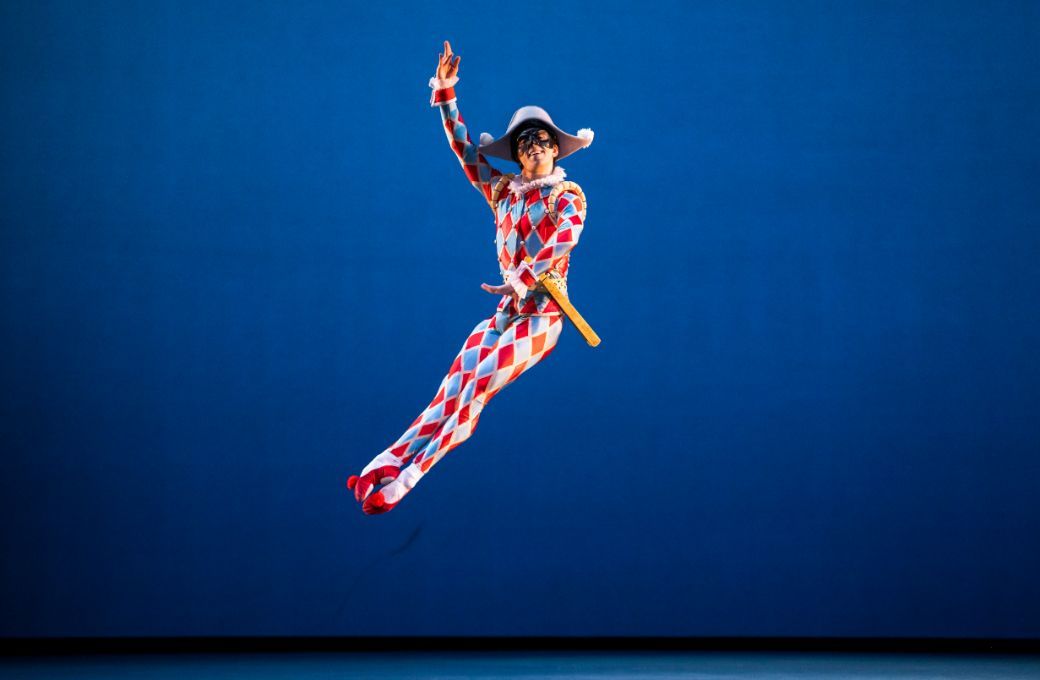Galas can be tricky things to programme: a balancing act between well-known showpieces and excerpts from the company’s repertoire. David Hallberg, Australian Ballet’s Artistic Director, presents his company in the best possible light, with some of the prerequisite fireworks and a selection of old and contemporary highlights from the current season. The occasion was to celebrate the 60th anniversary of The Australian Ballet.

The performance began with an excerpt from Harlequinade (Marius Petipa), originally premiered in St Petersburg in 1900. Alexei Ratmansky restaged and added choreography for American Ballet Theatre in 2018 and Australian Ballet acquired the production in 2022. In spite of its age, the first thing to note is that it looks fiendishly difficult to dance. It is a little bit twee and the narrative is a tad slapstick, but one should reserve judgement until such a time as it can be seen in its entirety. The good news is that the dancing was superlative: a well drilled corps and outstanding performances from Sharni Spencer as Columbine and Marcus Morelli as Harlequin.
Amy Harris and Nathan Brook gave an elegant account of the pas de deux from Kenneth MacMillan’s Concerto but it’s difficult to avoid the ghosts of previous interpreters on the Royal Opera House stage. Without wanting to take anything away from their individuality, it missed something of the mesmeric quality that is essential. An excerpt from Johan Inger’s I New Then followed, set to Van Morrison’s Madame George. Thoroughly enjoyable though it was, with its slinky moves, sometimes skittish, sometimes laid back, it also made less impact because it was just a part of the whole.
The first half finished spectacularly well with Ako Kondo and Chengwu Guo giving their all in Balanchine’s Tchaikovsky Pas de Deux. It was hard to refrain from whooping with delight at every juncture as both artists delivered such musical, accomplished performances. Guo has an enviable jump (double cabrioles that raise eyebrows) and soft landings that would rival any feline contender. Kondo breathes life, excitement and delicate precision into every step. Even a missed lift (a heart in the mouth moment!) could not dampen the rapturous and well-deserved reception from the audience.
Justin Peck’s Everywhere We Go (another excerpt) worked well even as a slice of the whole ballet. Set to a score by singer-songwriter Sufjan Stevens (orchestrated by Michael P. Atkinson) the tremendous pace, the cleverness of the ensemble patterns and the sheer mastery of the shapes and intricacies of the choreography, was a thrill to watch. The white bottomed leotards for the women are not particularly flattering, but in spite of this, the company looked fabulous. Brett Chynoweth as Andy and Imogen Chapman as Rebecca were particularly riveting.
Harris and Brook returned to the stage in a pas de deux from Yuri Possokhov’s Anna Karenina with music by Ilya Demutsky. I instantly thought this might not work out of context, but I was wrong. The pair managed to inject such dramatic weight into the brief episode that they made a prodigious impression.
An excerpt from Pam Tanowitz’s Watermark, created for The Australian Ballet in 2021, to music of the same name by Caroline Shaw, would also have benefited from being seen in full. The quirkiness of her choreography, and I do like the way she swings from very classical steps that morph seamlessly into a distorted contemporary move, takes a little time to assimilate. Performed with commitment, this one calls for a revisit, to better understand what she is trying to portray.
Little Atlas by Resident Choreographer Alice Topp, supremely danced by Dimity Azoury, Jarryd Madden and Jake Mangakahia, was an intriguing exercise in adagio strength and elasticity. Azoury is gifted with extremely high extensions and flexibility, but this can occasionally distort the body to the extent that the aesthetics are lost. A lift where the dancer is held up to the audience and her legs are split sideways, is not that attractive. Bare-legged, in a skimpy black leotard, I feared for her modesty.
It was, nevertheless, a great contrast to the closing number – excerpts from Rudolf Nureyev’s Don Quixote. Initially, I prepared myself for a bog standard pas de deux. Wrong again. We were treated to a very vigorous display from the Fandangos, led with aplomb by Dana Stephensen and Joseph Romancewicz. The pas de deux itself was far from run of the mill, danced by Benedicte Bemet and Joseph Caley. They brought the house down. Having seen Bemet dance the lead in Diamonds earlier in the week, I was expecting something exceptional. Caley, I have seen dance many times with both ENB and BRB and always thought him to be an excellent dancer. However, this was off the scale. Both were on top of their game, displaying absolute control with a kind of understated virtuosity. The “tricks” were breathtaking, spinning and jumping with jaw-dropping agility, whilst making it all look straightforward. A slip in her series of fouettés did not make Bemet flinch. Caley was on fire. He was better than I have ever seen him. Whatever he’s doing down under, it suits him very well.


